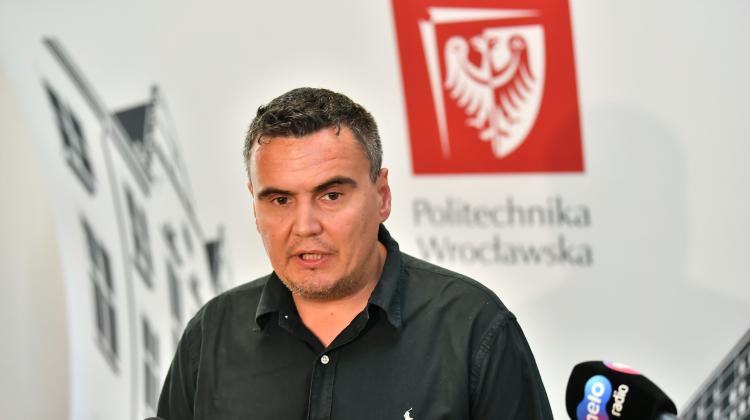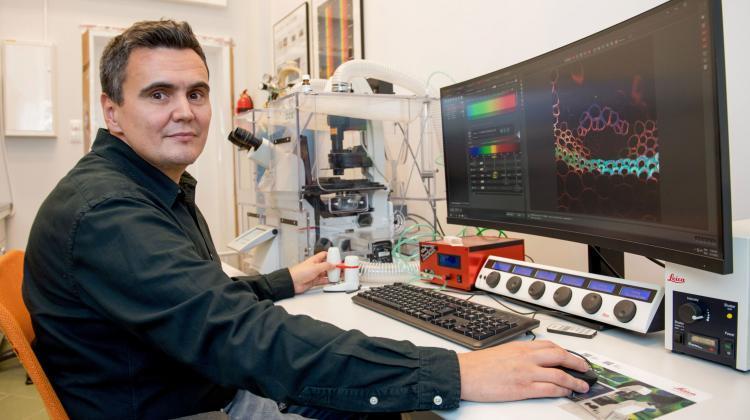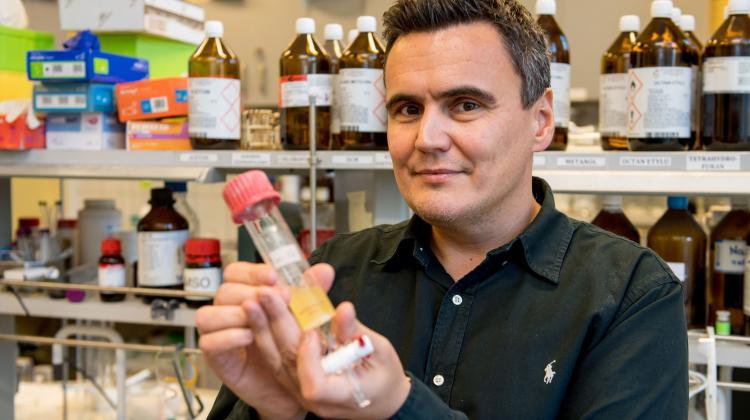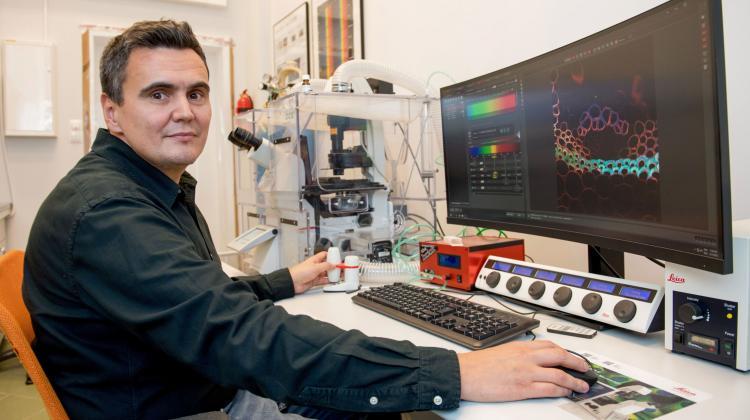Professor Marcin Drąg: I have seen the light side and dark side of science during the pandemic
 9.08.2020. Professor Marcin Drąg. PAP/Maciej Kulczyński
9.08.2020. Professor Marcin Drąg. PAP/Maciej Kulczyński
‘I have seen the light side and dark side of science during the pandemic. I deliberately devote myself to science, not to business, because I do not want to lose my research freedom and independence,’ says Professor Marcin Drąg, chemist and creator of a laboratory used, among other things, to do research on the coronavirus.
Professor Drąg built a biological chemistry and bioimaging laboratory from scratch at the Wrocław University of Science and Technology. Together with his team, he described the key enzyme of the SARS-CoV-2 coronavirus, paving the way for the COVID-19 drug Paxlovid, produced by Pfizer. During an interview with PAP, the scientist said how at the outbreak of the COVID-19 pandemic, his laboratory at the Wrocław University of Science and Technology was perfectly prepared to work on new antiviral drugs, important from the point of view of fighting the coronavirus.
'First, let us get the key thing straight - any research lab can be dangerous, because chemical compounds and biological substances that are stored there are dangerous. That is why we have security procedures and advanced training, to be able to quickly neutralize a dangerous compound or organism. A deactivated substance or organism is completely safe. Of course, there is a classification of the security level of laboratories, specifying how dangerous the materials they work with are, but it is not the case that +something leaks out+ every now and then,’ he says referring to popular theories during the pandemic that 'viruses escape from dangerous laboratories'.
'I propose to reverse thinking about laboratories as the source of all evil. Dangerous viruses have been with us from the beginning of our existence and will remain so. Laboratories are the only places where you can develop solutions to fight them. During he smallpox outbreak 500 years ago, entire villages died out - precisely because there was no way to develop effective treatments. All wars combined have not caused as much death as smallpox. Nobody knew how to control it. Now we have laboratories and thanks to the progress in science, we solved the problem of SARS-CoV-2 in three years, he says.
On a four-level security scale, his laboratory in Wrocław has been awarded level 2. This means that work is carried out with dangerous biological material, such as GMOs, but it is not possible to work there with an active SARS-CoV-2 virus (this is only possible in laboratories with security level 3 and 4). In Professor Drąg's laboratory, it is possible to work with a deactivated virus.
After completing his doctorate, Professor Drąg went to the US, where he studied unnatural amino acids. 'It was not a popular topic because there was no technology to help find the best unnatural amino acids and attempts to apply them in pharmacy had failed. However, I managed to develop a solution that worked and passed all experimental tests,’ he says.
He decided to return to Poland because, as he says, he was aware that setting up his own laboratory in the US would be very difficult, and 'this was the only way to achieve scientific independence.’
'I knew that if I didn't create my own place, having a superior over me, I would have to +share or give up my success+. I wanted to take the risk of independent work, educating young researchers and showing that world-class research in this field can also be conducted in Poland. I applied to the Foundation for Polish Science for the Focus grant. I got money for renovation, purchase of equipment, salaries for doctoral candidates. Perfect for a start,’ he says.
A small team of researchers started work in 2009 in the fledgling laboratory. Once the technology was ready and the scientific paper presenting the discovery sent for review, they travelled to South Africa to present the results of their work at the International Proteolysis Society conference.
'During the lecture, I presented the technology we used and explained how it could be used in the search for drugs, imaging markers, structures leading to further research or new types of receptors. Many people gathered at this conference immediately noticed the potential and we were simply flooded with offers of cooperation from academic laboratories and industry,’ Professor Drąg continues.
With new orders came the money for the expansion of the laboratory, and the team became more and more independent, as the researchers consistently developed the thematic area in which the scientific community had doubts.
'We have often heard the accusation that this was an academic science without practical applications. I have heard many times that unnatural amino acids were toxic, dangerous and could not be used in practice. This was not true, because even back then there were drugs the structures of which contained single unnatural amino acids,’ he says.
Professor Marcin Drąg's friendship with the German biochemist, Professor Rolf Hilgenfeld from the Institute of Biochemistry at the University of Lübeck, was important for his success. Hilgenfeld conducted intensive research work during the first SARS epidemic in 2002/2003. Other viruses, such as Zika and Ebola, were also the subjects of his work.
'Rolf often told me that we would have a pandemic for which we were not prepared at all because there were no tests and no drugs. He said that it would probably be a coronavirus pandemic, because it was only by a miracle that the first SARS epidemic in 2002/2003 did not spread all over the world. And I believed him. I myself tried to spread this information, but everyone doubted it, even virologists. Everyone claimed that this problem could only affect Asia, and that the global pandemic was an invention of filmmakers,’ Drąg says.
Despite this reaction, the scientist decided to create his library for the study of proteases (proteolytic enzymes) dedicated to coronaviruses. Enzymes from the SARS-1 and MERS coronaviruses were supposed to be brought for testing by Professor Rolf Hilgenfeld before Christmas of 2019, but instead he went to China to test the first drugs that were being developed for SARS-1. By coincidence, Hilgenfeld saw with his own eyes that the Chinese could not handle the new type of coronavirus, SARS-CoV-2 - and shared this news with Professor Drąg. Without waiting for events to develop, they both got to work.
'When the Chinese published the genome of SARS-CoV-2 on January 10, 2020, we saw that there were two proteases. Rolf started working on one of them (Mpro) to create a crystalline structure and shared his work with me upon his return in February 2020. He also brought this enzyme to me to Wrocław. This way, our library could be immediately used in research on SARS-CoV-2,’ says Drąg.
He adds: 'We knew from the SARS-1 story that stopping the Mpro protease would stop the virus from developing. We knew that this was the path we should follow - that this was our medical goal. We compared the library with the Mpro protease from SARS-1. We concluded that the active site in both enzymes was identical. We identified the amino acids that should be included in the composition of the drug.’
The scientists were the first to publish their discovery on the bioRxiv platform - an open access system. 'It was the beginning of March 2020, the time of the greatest panic and waiting for patient zero in Poland. The work enjoyed enormous interest. I had hundreds of calls from journalists, politicians and ordinary people,’ says Drąg.
'It was also then that the predatory science politics began. I got a lot of unethical cooperation offers. These were offers from Poland and abroad. In exchange for certain benefits, I was offered to hand over the laboratory, intellectual property and people, or to hand over the research topics we had been working on for so many years. Our grant applications were first rejected as 'no chance of implementation', and then we immediately received proposals to re-submit them in consortia with biotech companies or research institutes that had no idea about this type of research. All for amounts that were often several dozen times higher than those for which we had applied, and taking into account additional people and their friends, who, as it now turns out, previously evaluated and rejected our applications. The saddest thing is that many of these people are renowned scientists, who consider themselves authorities in science, or employees of grant agencies. Of course, I never agreed to any of these offers,’ says Professor Drąg.
As the scientist recalls, there were also false reports about ongoing cooperation between him and strangers, research groups, and even companies. 'Based on the results we published on substrates for the search for new drugs, global companies began to sell these reagents for huge amounts of money without our consent,’ the scientist says.
In order to control the situation, the Wrocław University of Science and Technology signed an agreement with the Japanese company Peptide Institute Inc. for the distribution of chemical compounds developed in Professor Drąg's laboratory.
In March 2021, Pfizer published a molecule that they intended to use to create a drug against COVID-19. It contained three unnatural amino acids. One of them was the optimal one indicated by Professor Drąg and Professor Rolf Hilgenfeld in a paper published a year earlier.
'I was very happy about it, because only a large company could afford to conduct comprehensive clinical trials that could finally confirm that my theory of using unnatural amino acids as one of the ingredients of drugs worked. And in addition, it was able to solve one of the most pressing public health problems in the world,’ says Drąg.
And that was what happened. Paxlovid was clinically tested and approved by the US Food and Drug Administration (FDA).
'It would be impossible for me and my laboratory to produce the drug in such a short time and to carry it through the complicated procedure of the American institution that approves new drugs - the FDA,’ Drąg says. He adds that with earlier proposals to search for drugs using only unnatural amino acids, the institutions approving drugs for use were very sceptical.
When asked about how to talk about the impact of 'big pharma' on the development of medicine and extinguishing public health crises, the scientist says that it is necessary to talk openly about various models of cooperation and what results from them. The simplest model of cooperation with pharmaceutical companies is the so-called 'fee for service' - that is, money for developing a solution.
'We tend to avoid this model because we prefer a partnership approach. So - in addition to money - the company gives us the opportunity to use its resources (other solutions, applications unique to this company). As part of this cooperation, we get biological material to which there is normally no access. We also have access to their scientists and know-how. This is a mutual exchange, which involves using the potential of the institution, and not just delivering the product, says Drąg. He adds that a very valuable part of partnership cooperation with pharmaceutical companies is the possibility of jointly publishing scientific papers.
Another model of cooperation concerns sharing intellectual property. This is important in the patent application process.
When asked why he was not tempted to work only in business, Professor Drąg says: 'I deliberately chose to work in academic science, not in +big pharma+, although I could have done it with great success. Many people are tempted to work in business because there is a lot of money involved, but then you often realize that you are losing your scientific freedom. Going to the industry, we are implementing a project that someone can shut down at any time, because +the concept has changed+. You also can't publish all your discoveries (because there is no time or approval from your superiors), and then it is gone. I do not like this type of work. I have a completely different life philosophy. I like science because I can do things that go against the intuition of the scientific community, or something that simply interests me.’ (PAP)
PAP - Science in Poland, Urszula Kaczorowska
uka/ bar/
tr. RL
Przed dodaniem komentarza prosimy o zapoznanie z Regulaminem forum serwisu Nauka w Polsce.


















